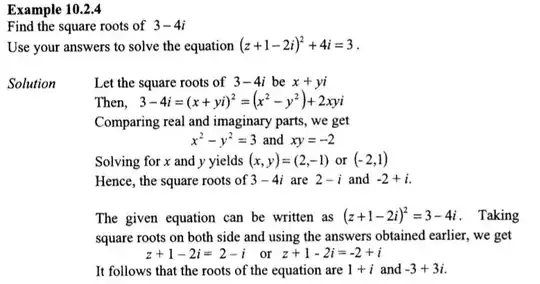
What I did
$z^2=3-4i$
$(a+bi)^2 = 3-4i$
$a^2-b^2+2abi = 3-4i$
Then got 2 simultaneous equations
$a^2-b^2=3$ and $2ab=-4$
Solve for $a^2$ in 1st equation: $a^2=3+b^2$
Subbed into 2nd equation to power of 2
$(3+b^2)b^2=4$
$b^4+3b^2-4=0$
Is there a better way than below? Solving power 4 equation then cubic?
Then solved solved power 4 equation ...
$(b-1)(Ab^2+Bb^2+Cb+D)=b^4+3b^2-4$
$(b-1)(b^3+b^2+4b+4)=b^4+3b^2-4$
then solved for cubic equation, getting ...
$(b-1)(b+1)(b^2+4)=0$
So
$b=\pm 1 \text{ or } 2i$
What did the book do now?
I did: (subbing into $a^2=3+b^2$)
When $b=1, a^2=3+1^2 \Longrightarrow a = 2$
When $b=-1, a^2=3+(-1)^2 \Longrightarrow a=2$
When $b=2i, a^2=3+(2i)^2=3+4(-1)=-1, a=i$
So I will have 3 equations
- $2+i$
// why is this not in the book? - $2-i$
- $i-2$
UPDATE (In response to @David Mitra)
Ok. I let $x=a^2$ and $b=b^2$ giving the quadratic equation: $x=3+y$ and $xy=4$. Then (after subbing) $(y-1)(y+4)=0$
Then when $y=1, x=4$. $y=-4, x=-1$
Then $b=\pm 1 or \pm 2i$ and $a=\pm 2i or \pm i$
Finally testing equations:
$(2+i)^2 = 3+4i$ (rej)
$(2-i)^2=5$ what to do?
$(i-2)^2=3$
$(-2-i)^2=3$
... 8 equations (but 4 unique)